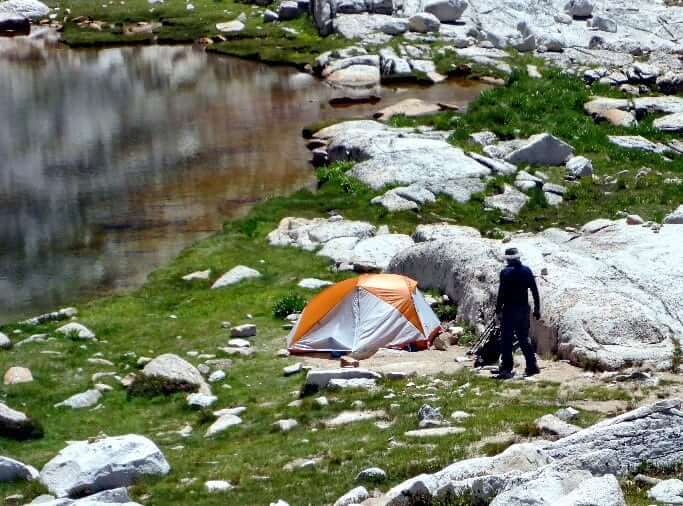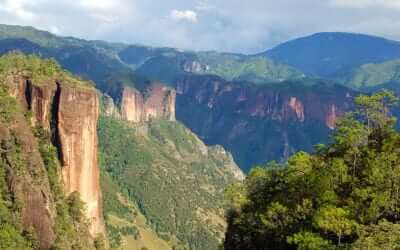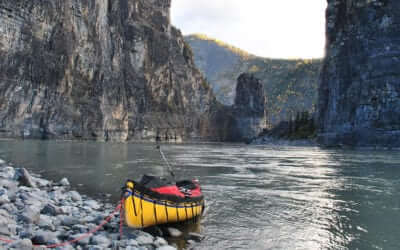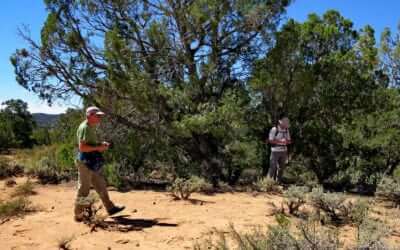Photo by Adrian on Unsplash
Conflicting Messages about Camping Near Waterbodies in Wilderness: A Review of the Scientific Basis and Need for Flexibility
Communication & Education
August 2018 | Volume 24, Number 2
PEER REVIEWED
The preceding article by C. B. Griffin examines the differences in recommended camping distance from waterbodies from a perspective that there should be consistency between the guidance provided by land management agencies and low impact education and communication programs, such as Leave No Trace and Tread Lightly. We concur that regulatory and messaging consistency is a beneficial mutual goal and suggest that it’s time to reexamine the biophysical and social scientific basis for such guidance, historical precedents, alternative management options, and where there are needs for flexibility. We also identify possible additional research needs and suggest alternative actions based on the current body of research.
Background
Land managers have commonly sought to discourage or prohibit camping near surface waters (e.g., lakes, rivers, streams, and springs), imposing regulations that prohibit camping within a specified distance from water. As Griffin presents, these camping setbacks from water within US Forest Service wilderness areas currently range from 50 (15 m) to 1,320 feet (402 m), with 100 feet (30.5 m) as the most common prohibition, followed by 200 feet (61 m), which is the distance recommended by the national Leave No Trace and Tread Lightly programs (Leave No Trace 2018, Tread Lightly 2018). An earlier survey by Washburne and Cole (1983) reported the following percentages of agency management units that employed camping setback from water regulations: U.S. Forest Service (USFS) (37%), National Park Service (NPS) (22%), Fish and Wildlife Service (FWS) (7%), and Bureau of Land Management (BLM) (18%). Distances ranged from 20 to 2,640 feet (6 to 805 m), with 100 feet as the most common distance. In 1992, Marion, Roggenbuck, and Manning (1993) surveyed NPS units with substantial backcountry and wilderness with similar findings: 41 units (44%) employed camping setback from water regulations, with a range of 5 (1.5 m) to 2,640 feet and 100 feet as the most common value (22 units, 23%).
Despite consistent recommendations from Leave No Trace for the past 20 years regarding camping a minimum of 200 feet from any water source, some local regulations differ from these recommendations for a variety of reasons. The NPS, for example, sometimes locates designated campsites within 200 feet of water sources due to unique contextual constraints imposed by local topography or other factors. As collaborative partners of the federal land management agencies, Leave No Trace and similar educational programs default to federal regulations for their individual units. However, such programs generally recommend extra precaution when camping in areas that are closer to surface waters than they would otherwise recommend. Land management agencies often have specific reasons for siting recreational facilities that encompass more than one criterion, such as proximity to water, hence the standard guidance asking visitors to discover and abide by agency regulations for the unit they are visiting.
The national Leave No Trace program is managed by the 501(c)3 Leave No Trace Center for Outdoor Ethics (the Center). Five of the primary federal land management agencies have been under a Memorandum of Understanding (MOU) with the Center since 1994 and include the NPS, BLM, USFS, FWS, and the Army Corps of Engineers. Through the MOU, these agencies have agreed that Leave No Trace is their minimum impact recreation program for nonmotorized recreation (Marion 2014; Vagias and Powell 2010). Functionally, this means that the federal land management agencies disseminate Leave No Trace recommendations to visitors to the lands they manage. Although the MOU aims for a consistent message to public lands visitors, local adaptations are sometimes necessary.
The 200-foot camping setback from water was selected in the early 1990s by the Leave No Trace program’s Education Review Committee, composed of representatives of the federal land management agencies, scientists, Center staff, and organizations such as the National Outdoor Leadership School. As for many other educational practices, an appropriate “universal” number was selected that would be generally applicable to the diverse array of environmental settings that occur nationally within protected natural areas. In some locations a 200-foot setback may not be necessary to protect surface waters, whereas in others it may be inadequate. The Leave No Trace program generally sought to err on the side of resource protection, while seeking to provide educational consistency by establishing a universal distance to guide campers in their decision-making regardless of the location or environment.
There were three primary reasons prioritized by the Education Committee for the 200-foot Leave No Trace guideline: (1) to avoid or minimize pollution of surface waters, 2) to facilitate wildlife access to water sources, particularly in arid environments, and 3) to promote visitor solitude and reduce recreational conflict. In more mesic environments wildlife access to water is not a concern, and deeper soils with organic litter and dense ground vegetation cover, particularly grasses and sedges, are able to filter water draining from riparian campsites camping only 100 feet from water. Conversely, 200 feet could be inadequate in Colorado Plateau locations due to limited water sources for wildlife and the potential for human-introduced pollutants to enter water sources from rain events within extensive areas of slick rock or thin soils.
A final consideration regarding potential inconsistencies between Leave No Trace recommendations and agency guidance for camping distances from surface waters in wilderness is that the Wilderness Act was enacted 30 years before creation of the formal Leave No Trace program. The establishment of camping setbacks from water for many wilderness areas predated the development of the Leave No Trace program guidance and their agency’s adoption of Leave No Trace messaging. Regulations are typically infrequently updated, particularly in the absence of clear scientific evidence to the contrary. The following sections examine visitors’ attraction to camping near water and the scientific literature for possible guidance based on ecological, cultural/historic, social/experiential, and wildlife and rare/sensitive species research and management concerns.
Social Science: Visitors Are Attracted to Water
As reviewed by Griffin (this issue), visitor surveys have demonstrated that visitors prefer to camp near water. In a comprehensive early study, Lime (1971) interviewed northern Minnesota campground visitors and analyzed campground occupancy rates to investigate visitor preferences affecting campsite selection. Lime identified three groupings of 74 factors that could affect campground occupancy. Location factors included proximity to main travel routes, towns, and other recreational facilities. Natural environment factors included vegetation type, scenery, fishing, and geography (including proximity to water). Human-made environment factors included the facilities and services available, fees, campground age, campsite spacing, and number of waterfront campsites. Regression modeling of 25 possible factors explaining campground occupancy data yielded three significant factors (R2=.77), including (1) the percentage of waterfront campsites (explaining 84% of variation), (2) the reputation of the water body for fishing (8%), and (3) the length of time the campground had been open (7.6%). Analyses of 248 visitor interviews reinforced the regression results, revealing the most important determinant for campsite selection was obtaining a waterfront campsite (77% of respondents) (Lime 1971).
More recent research specific to wilderness visitors’ campsite choices in Oregon’s Mt. Jefferson Wilderness reveals similar findings three decades later. White, Hall, and Farrell (2001) identified 5 groupings of 23 factors that might influence campsite choice. Based on open-ended semistructured interviews, their results revealed that locational features were the most frequently cited (62%), with proximity to water the most referenced feature of any type (38%). Social factors were also important, with 22% reporting that they chose their site because it was not too close to other groups.
These and other surveys reveal that visitors are strongly attracted to water in both frontcountry (developed) and wildland settings. Their reasons are varied and include the need for water, scenic beauty, the unique nature of riparian settings, opportunities to see wildlife and explore shorelines, fishing, swimming, and the relaxing sound of water. This attraction, however, poses challenges for land managers seeking to provide high-quality recreation experiences while protecting natural and cultural resources. In wilderness, managers are particularly concerned about visitor freedom from regulations, preferring indirect actions when effective. For example, Lucas (1982) used camping setbacks from water as a regulatory example throughout an article titled “Recreation regulations: When are they needed?” Lucas suggested beginning the decision process by describing the problem, which for camping setbacks can be ecological (are riparian shorelines more vulnerable to resource impacts than more distant locations?), or social (are shoreline campsites too visible, is solitude diminished, or are there conflicts with other visitors?). The following problem description section examines some of the existing literature related to these ecological and social questions.
Problem Description: Shoreline Camping
Ecological Concerns
Campsites pose a potential threat to vegetation, soils, water quality, and wildlife. Camping activities frequently reduce or remove vegetation ground cover and organic litter, which play an important role in preventing soil erosion (Marion et al. 2016). In sunny settings, grass and sedge cover can survive low to moderate levels of trampling due to their substantially greater resistance and resilience (Cole 1995b; Cole and Monz 2002). Only the most intensively trafficked portions of grassy campsites lose their protective vegetation cover (Cole 1982b, 1995a, 1995b) (Figure 1). In contrast, most campsite vegetative cover is lost with low levels of camping activity in forests with closed canopies, along with the pulverization and loss of underlying organic litter, which exposes organic and mineral soils in core areas to rainfall and erosion (Cole 1995a, 1995b) (Figure 1). Given that most shorelines slope directly to water, a significant ecological concern is the threat of water runoff from barren campsites carrying organic materials, sediments, and pollutants from campfire ashes, soap use, urine, or human waste.
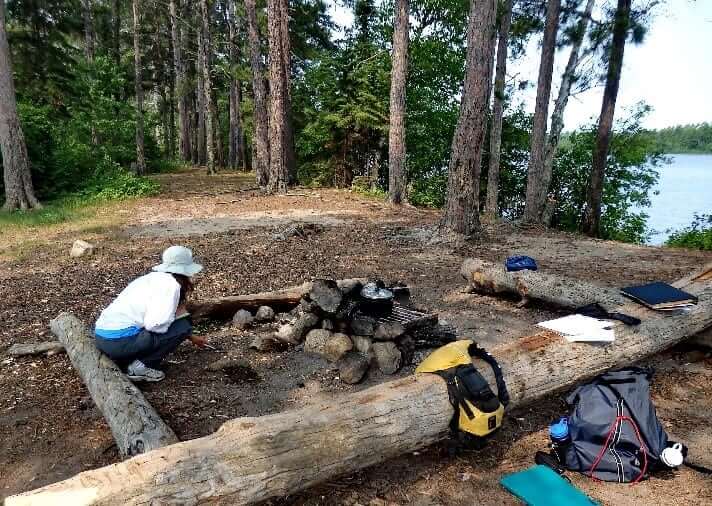
Figure 1b– In Fig 1a and 1b, sun-loving grasses and sedges can sustain all but the most intensive trampling on this high-elevation lake campsite in Sequoia Kings Canyon National Park, CA (top). In contrast, shade-tolerant herbs are quickly lost on forested campsites such as this one in Minnesota’s Boundary Waters Canoe Area Wilderness (BWCAW) (bottom).
Runoff from shoreline campsites drained straight to water is particularly problematic. Campsite drainage that collects and flows along an incised water access trail or natural drainage swale directly to a water body poses a substantial threat to water quality (Figure 2). In contrast, campsites that drain with sheet flow through more than about 25 feet (7.6 m) of relatively undisturbed vegetation and organic litter are likely to pose little threat to water quality (Figure 1, grassy site). A review of US guidelines for forested riparian buffer widths to protect against the considerably greater disturbances associated with timber harvesting reported values ranging from 50 to 79 feet (15-24 m) for different waterbody types (Lee, Smyth, and Boutin 2004).
A key challenge is to promote water drainage from campsites through sheet flow to reduce water flow rates to levels that will drop suspended materials, facilitate filtering by surface vegetation and organic litter, and allow water to percolate into shoreline soils. As demonstrated in Figure 2, it may be possible to reroute water access trails so they do not drain campsites to a water body, provided the original trail can be effectively closed and blocked to allow natural or assisted recovery. Alternately, a 200-foot campsite setback is likely sufficient so that natural obstacles such as rocks or roots remove water, or to allow the installation of effective tread drainage features. Shoreline riparian areas with substantial rock, thin soils, or that lack vegetation and litter cover likely pose a greater threat to polluting surface waters.
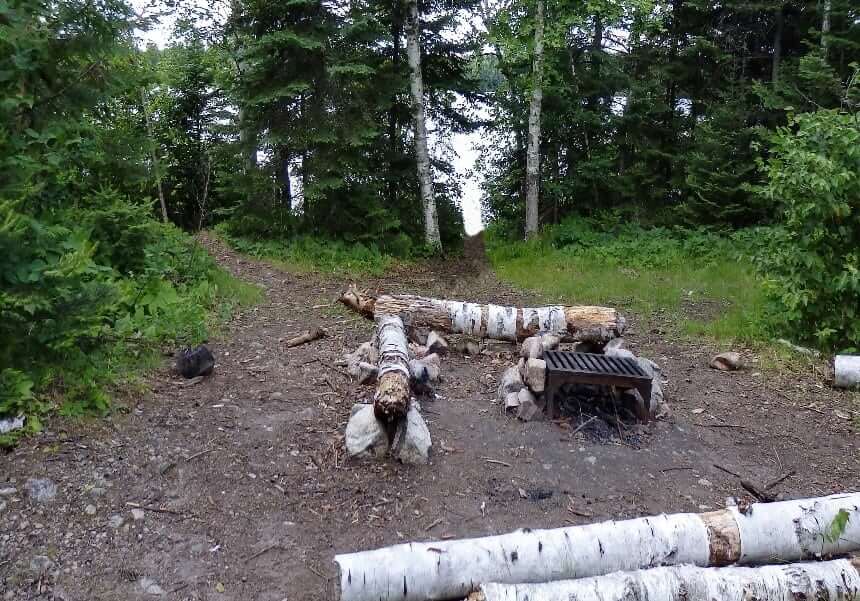
Figure 2 – This partial view of a large BWCAW campsite reveals that water runoff is drained down a fall-line water-access trail (back center) about 150 feet to the lake. This trail could be closed and blocked with water-filtering rocks, logs, organic materials, and vegetation so that visitors use the alternate trail (back left) that initially ascends and can’t drain campsite water.
An additional concern for shoreline campsites along streams and rivers is the increased potential for soil erosion during flooding events. Camping activities generally remove most ground vegetation cover on campsites as well as the reduction and removal over time of shrub and tree cover. Plant roots play an important role in inhibiting soil loss during flood events, so soil removal from campsites by flood waters is likely more prevalent than in adjacent undisturbed areas (Cole and Marion 1988; Marion 1995). Soil loss and many other ecological impacts can be minimized by reducing the size of shoreline campsites and their shoreline disturbance to the minimum necessary. Campsites larger than around 1,000 feet2 (93 m2) might be considered excessively large, with actions taken to reduce the areal extent of vegetation loss and soil exposure (Marion 2016).
In some protected areas managers require camping close to water on barren shorelines or sandbars that are naturally devoid of vegetation due to frequent flooding or wave-action. For example, land managers may ask river users to camp on nonvegetated substrates and avoid camping in adjacent higher and more distant vegetated riparian areas (Marion 2014), and in arid settings campers may be directed to use nonvegetated dry washes for camping. A significant concern with these practices is that visitors can predict flooding with sufficient notice to strike camp and relocate to a safe location.
Studies of camping impacts to water quality report mixed results. Visitor use was not found to affect water quality in a study of high- and low-use lake basins in Kings Canyon National Park, California (Silverman and Erman 1979). A study of campsites in the BWCAW found slightly elevated levels of total coliform bacteria and available phosphate compared to controls (King and Mace 1974). Leachate from pit toilets were identified as the source of pollutants. Derlet and Carlson (2006) found high levels of coliform bacteria at 12 of 15 campsites that had heavy pack-stock use in the area in a study of 60 lakes and streams in the Sierra Nevada range of California. In contrast, areas that were exclusively used by backpackers were nearly free of coliform bacteria.
To investigate if lakeshore campsites were more vulnerable to impact, Cole (1982a) compared conditions on five high-use campsites in Oregon’s Eagle Cap Wilderness within 200 feet of lakes to five “setback” sites more than 200 feet from lakes. A 200-foot camping prohibition had been in place for several years, but Cole cautions that compliance was low, and enforcement had been difficult. The lakeshore campsites were likely the oldest and most heavily used historically, and since establishment of the camping setback regulation the lakeshore (illegal) and setback (legal) sites had similar use levels. Results revealed that lakeshore campsites were somewhat larger but had less bare ground (areal extent and percent). They also had more vegetation cover, with a composition that was more like adjacent undisturbed areas than the setback sites. Of 20 indicators examined, only a reduction in tree seedlings was statistically significant, leading Cole to conclude that the lakeshore campsites were not more fragile than setback sites.
Cultural and Historic Concerns
Today’s visitors are not unlike their distant ancestors, many of whom lived or also camped near water. Thus, shorelines often have cultural or historic sites, particularly in more arid environments. While some of these sites have been found and documented, many more may exist but are undocumented or hidden below ground. Camping activities that remove protective vegetation and soils may expose cultural and historic resources to theft, damage, or to being eroded by stream or river flooding (Wildesen 1982). Full protection of these sites could require greater setback distances than those commonly employed (e.g., >200 ft.).
Social and Experiential Concerns
Campsites on or near shorelines tend to be more visible than those set back from water, both from across the water and from vista points along adjacent ridges and summits. The presence of barren campsites within a view shed can diminish the feeling of being in a pristine wilderness, can mar the natural appearance of a photo, and can diminish the aesthetics of natural landscapes. Occupied campsites may diminish solitude, particularly given that they become more visible with colored tents and with sounds traveling farther across water (Cole 1982a). Anglers and other visitors traveling along lakeshores may feel that the shoreline has been turned into “private territory” when they encounter an occupied campsite, creating conflict between day-use and overnight visitors (Lucas 1982). Large numbers of highly visible and occupied shoreline campsites can exacerbate visitor crowding for both campers and day users. Campsites set back from the water are generally less visible and pose fewer problems related to both crowding and conflicts (Cole et al. 1987).
Wildlife and Rare/Sensitive Species Concerns
Water is as essential to wildlife as it is to humans, and riparian zones are particularly important due to the significantly higher diversity and productivity of both flora and fauna (Taylor and Knight 2003). Riparian zones represent important habitats for many wildlife species, especially in arid environments where dependable water sources are rare. Some wildlife, such as bighorn sheep, are considerably more vulnerable when separated from steep terrain and are easily displaced from water by the presence of humans (Papouchis, Signer, and Sloan 2001). When camping occurs in riparian areas wildlife may be deterred from visiting water sources even at night. Similarly, riparian areas may be a critical component of the habitats for rare flora and fauna or can be particularly sensitive to the negative effects of intensive visitor use and trampling.
When camping is unregulated, visitors may create unnecessarily large numbers of campsites in popular destinations areas. For example, Cole (1982a) assessed camping impacts around two popular subalpine lakes in Oregon’s Eagle Cap Wilderness several years after implementation of a camping prohibition within 200 feet of lakeshores. Most of the 221 campsites assessed were “within a few hundred feet of water.” Cole suggests that many of these campsites and their resource impacts are “avoidable” given that only about 10 groups camped within the area on typical nights, and even peak use would “never exceed several times this figure.” Campsite proliferation to numbers that substantially exceed actual need can be a common problem associated with unregulated and general dispersed camping polices, including in eastern wilderness areas (Reid and Marion 2004).
Complexity and Challenges of Camping Management in Riparian Zones
Camping setbacks seek to shift camping away from water, which as previously discussed is an exceptionally strong attractant to visitors. Our review of ecological, cultural, social, and wildlife concerns provides ample support for shifting camping away from the shorelines of water bodies. However, we note that it is possible for riparian campsites to be carefully located and managed to avoid or substantially minimize the impact management concerns presented. Two significant problems identified for areas where visitors retain the freedom to select campsites are (1) the proliferation of campsites (often within popular shoreline riparian areas) to excessive and unnecessary numbers, and (2) universally poor visitor compliance with regulations that establish camping setbacks from water. An additional concern is when camping in popular flat shoreline locations creates excessively and unnecessarily large campsites and/or dense clusters of campsites that threaten experiential qualities.
There is evidence that managers may not achieve the closure and recovery of shoreline campsites made illegal by a camping setback regulation due to their popularity and continued use by visitors, and that such regulations promote campsite creation in new areas that meet the setback regulation (Cole 1982a; Cole et al. 1987; Lucas 1982). To the extent that this occurs, camping setbacks will increase campsite numbers and aggregate areal measures of camping disturbance (Cole 1981). Other objectives, such as protecting water quality, promoting solitude, and reducing conflicts, are also not achieved when compliance rates with setback regulations are low and shoreline campsites persist. Research indicates that all use must be eliminated for these campsites to achieve substantial or full recovery, and management experience in most areas suggests this is exceptionally difficult to achieve (Cole 2013; Cole and Monz 2003; Cole and Spildie 2007). Even continued legal day-use activities of shoreline campsites by visitors to swim, eat lunch, or relax can prevent their recovery.
Unfortunately, after three to four decades of management experience with camping setback regulations, we still concur with the 1982 assessment by wilderness scientist Bob Lucas that camping setback regulations have been largely ineffective in achieving management objectives: “I would conclude that the costs of a camping setback regulation to management and to visitors in terms of less desirable campsites and enforcement hassles exceed the benefits of greater campsite solitude” (Lucas 1982). We also note that visitors and enforcement staff can be challenged to accurately judge varying camping setback distances – visitors need a clear and unambiguous policy that also includes a compelling rationale.
We suggest that shifting to a camping “containment” strategy with designated sites can be a preferred and more effective policy. Under this strategy managers would carefully select only the most sustainable campsites and then close and restore all others. Cole (1981) recommends this strategy, noting that providing some riparian campsites avoids eliminating preferred existing sites and limits increasing campsite numbers further from the shore. This camping management strategy is fully described by Marion, Arredondo, Wimpey, and Meadema in this issue of IJW, along with supporting recreation ecology research findings (Marion 2016). This strategy is characterized by a broader view of decision-making that incorporates ecological, social, and managerial contexts. An integrative policy can address all the concerns in the prior problem description section while permitting a limited number of highly sustainable campsites in riparian settings that promote the high-quality camping experiences that many visitors so strongly desire.
An integrative policy should address all the concerns … while permitting a limited number of highly sustainable campsites in riparian settings that promote the high-quality camping experiences that many visitors so strongly desire
There is evidence that the public will be supportive of a designated site camping strategy. For example, Cole et al. (1997) report that visitors to six high-use areas within three Pacific Northwest Wilderness areas neither favor nor strongly favor camping prohibitions around lakes (8–22%) but were considerably more enthusiastic for allowing camping only on designated sites (44–85%). We believe that the “costs” to visitor freedom and related wilderness character concerns associated with replacing an ineffective camping setback regulation with a designated site camping regulation are more than offset by the “benefits” of eliminating the aggregate impacts associated with large numbers of unnecessary riparian campsites (Landres et al. 2008).
Designated site camping has been effectively implemented by numerous land management agencies in riparian settings. US Forest Service managers of the BWCAW have successfully operated more than 2,000 designated campsites for more than four decades in northern Minnesota. Long-term research reveals an extremely high level of compliance with this designated site camping, and equivalent success in their ability to manage resource and social impacts within acceptable levels of change in this heavily visited wilderness (Eagleston and Marion 2017). Similarly, Forest Service managers of the Alpine Lakes Wilderness in Washington have long restricted camping to designated campsites around most lakeshores. Visitors with pack and saddle stock are prohibited from camping around lakes and are allowed only at designated sites within .5 mile (800 m) of lakes. Forest Service managers of the Desolation Wilderness in California restrict camping to designated campsites within 500 feet of four particularly popular lakes (Lake of the Woods, Grouse, Hemlock, and Eagle). Designated campsites are first-come, first-served, one permitted group per site, and visitors are asked to camp within 30 feet (9 m) of camping posts. When these sites fill visitors must camp more than 500 feet from the lakeshore. Observations by the authors reveal high visitor compliance and the near recovery of older adjacent closed campsites. These policies can help to establish a clear and easily adopted practice that allows many visitors to camp in their preferred destination, which can promote greater compliance among those who are unable to obtain a desired site.
We suggest that a containment strategy (1) can help eliminate unnecessary campsites, (2) can effectively shift use to the most sustainable “small-footprint” campsites that will resist expansion, and (3) allows flexibility to incorporate alternative setback distances dependent on the specific setting and type of resource in need of protection (water quality, riparian vegetation, wildlife, rare species, cultural resources, and recreational quality). Designated site camping offers a substantially more flexible and effective option for land managers in popular areas to limit campsite numbers and the areal extent of impact. We are less certain regarding the potential efficacy of a second containment strategy option, established site camping, which can either request or require visitors to use a selected subset of well-established campsites that have been rated as preferred and sustainable (see Marion, Arredondo, Wimpey, and Meadema in this issue for further information). This policy has been effectively implemented in the Shenandoah Wilderness (Reid and Marion 2004) and in many other areas where managers actively seek to close and restore unnecessary, and less resistant, desirable, and appropriate campsites.
In conclusion, we concur with C. B. Griffin that greater consistency between educational programs and land management agencies are a desired goal for low impact messaging, including guidance for camping setbacks from water. Visitors can benefit from consistent messaging provided by a diverse array of agencies and organizations as an important mutual goal. However such messaging may require deference provided to land managers allowing flexibility for historic precedents, differing agency objectives, and unit contextual needs.
Our review provides support for camping setback regulations based on ecological, cultural, social, and wildlife concerns. However, we also note that managers can and have carefully selected a subset of sustainable designated campsites near waterbodies that adequately protect those resources while retaining high-quality opportunities for visitors to camp near water. Cole (1981) offered a similar conclusion: “Concentrating use on as few campsites as possible and closure on a site-by-site basis would confine inevitable damage.” Unfortunately, our review suggests that several decades of management experience has not led to the widespread and successful application of camping setback regulations. We observe that visitors are very clearly “voting” through their risky campsite selection preferences; long-term persistence in camping illegally plainly demonstrates the strong desire to camp near water. Land managers can listen to their clients and consider designated site camping as an alternative to camping setbacks. Recreation ecology research and management experience has consistently demonstrated the efficacy and high success rate of designated site camping policies (Marion 2016).
Further Research Needs
Additional research can inform decision makers seeking to accommodate existing and increasing wilderness visitation while minimizing associated camping impacts and improving the quality of recreation experiences. While we are unaware of any “definitive” longitudinal studies designed to evaluate the efficacy of camping setbacks, research and extensive management experience has provided ample ancillary evidence describing numerous limitations and failures. Given our review of existing research, we suggest that additional studies focus on evaluating and improving the implementation of a containment strategy with designated site camping in popular high-use areas, including those proximate to water bodies, and established site camping in moderate use areas. Additional research can also examine effective methods for communicating camping management strategies, location and navigational information for finding preferred sustainable campsites, and spatial-based regulations and low impact camping practices for visitors.
Acknowledgments
The authors express their appreciation to a peer review conducted by David Cole and helpful comments from Ken Straley and Ralph Swain.
JEFFREY L. MARION is a recreation ecologist with the U.S. Geological Survey stationed at Virginia Tech; email: jmarion@vt.edu
JEREMY WIMPEY is the owner of Applied Trails Research, an outdoor recreation firm that develops science-based solutions to challenging visitor use management issues; email: jeremyw@appliedtrailsresearch.com
BEN LAWHON is education director for the Leave No Trace Center for Outdoor Ethics; email: ben@lnt.org
References
Cole, D. N. 1981. Managing ecological impacts at wilderness campsites: An evaluation of techniques. Journal of Forestry 79: 86–89.
———. 1982a. Controlling the spread of campsites at popular wilderness destinations. Journal of Soil and Water Conservation 37: 291–295.
———. 1982b. Wilderness Campsite Impacts: Effect of Amount of Use. USDA Forest Service, Res. Pap. INT-284. Ogden, UT: Intermountain Forest and Range Exp. Station.
———. 1995a. Disturbance of natural vegetation by camping: Experimental applications of low-level stress. Environmental Management 19(3): 405–416.
———. 1995b. Experimental trampling of vegetation. II. Predictors of resistance and resilience. Journal of Applied Ecology 32: 215–224.
———. 2013. Long-term effectiveness of restoration treatments on closed wilderness campsites. Environmental Management 51: 642–650.
Cole, D. N., and J. L. Marion. 1988. Recreational impacts in some riparian forests of the eastern United States. Environmental Management 12(1): 99–107.
Cole, D. N., and C. A. Monz. 2003. Impacts of camping on vegetation: Response and recovery following acute and chronic disturbance. Environmental Management 32(6): 693–705.
———. 2002. Trampling disturbance of high-elevation vegetation, Wind River Mountains, Wyoming, U.S.A. Arctic, Antarctic, & Alpine Research 34(4): 365–376.
Cole D. N., and D. R. Spildie. 2007. Vegetation and Soil Restoration on Highly Impacted Campsites in the Eagle Cap Wilderness, Oregon. USDA Forest Service, Gen. Tech. Rpt. RMRS-GTR-185. Fort Collins, CO: Rocky Mountain Research Station.
Cole, D. N., M. E. Petersen, and R. C. Lucas. 1987. Managing Wilderness Recreation Use: Common Problems and Potential Solutions. USDA Forest Service, Gen. Tech. Rpt. INT-GTR-230. Ogden, UT: Intermountain Research Station.
Cole, D. N., A. E. Watson, T. E. Hall, and D. R. Spildie. 1997. High-use destinations in wilderness: Social and biophysical impacts, visitor responses, and management options. Res. Pap. INT-RP-496. Ogden, UT: U.S. Department of Agriculture, Forest Service, Intermountain Research Station.
Derlet, R. W., and J. R. Carlson. 2006. Coliform bacteria in Sierra Nevada wilderness lakes and streams: What is the impact of backpackers, pack animals, and cattle? Wilderness and Environmental Medicine 17(1): 15–20.
Eagleston, H., and J. L. Marion. 2017. Sustainable campsite management in protected areas: A study of long-term ecological changes on campsites in the Boundary Waters Canoe Area Wilderness, Minnesota, USA. Journal for Nature Conservation 37: 73–82.
King, J. G., and A. C. Mace. 1974. Effects of recreation on water quality. Water Pollution Control Federation 46: 2453–2459.
Landres, P., M. B. Hennessy, K. Schlenker, D. N. Cole, and S. Boutcher. 2008. Applying the Concept of Wilderness Character to National Forest Planning, Monitoring, and Management. USDA Forest Service, Gen. Tech. Rpt. RMRS-GTR-217WWW. Fort Collins, CO: Rocky Mountain Research Station.
Leave No Trace. 2018. Leave No Trace website, www.LNT.org. Accessed 2 July 2018.
Lee, P., C. Smyth, and S. Boutin. 2004. Quantitative review of riparian buffer width guidelines from Canada and the United States. Journal of Environmental Management 70(2): 165–180.
Lime, D. W. 1971. Factors Influencing Campground Use in the Superior National Forest of Minnesota. USDA Forest Service, Res. Pap. NC-60. St. Paul, MN: North Central Forest Experiment Station.
Lucas, R. C. 1982. Recreation regulations: When are they needed? Journal of Forestry 80: 148–151.
Marion, J. L. 1995. Capabilities and management utility of recreation impact monitoring programs. Environmental Management 19(5): 763–771.
———. 2014. Leave No Trace in the Outdoors. Mechanicsburg, PA: Stackpole Books.
———. 2016. A Review and synthesis of recreation ecology research supporting carrying capacity and visitor use management decision-making. Journal of Forestry 114(3): 339–351.
Marion, J. L., Y. F. Leung, H. Eagleston, and K. Burroughs. 2016. A review and synthesis of recreation ecology research findings on visitor impacts to wilderness and protected natural areas. Journal of Forestry 114(3): 352–362.
Marion, J., J. Roggenbuck, and R. Manning. 1993. Problems and practices in backcountry recreation
management: A survey of National Park Service managers. Denver, CO: USDI National Park Service, Nat. Res. Rpt. NPS/NRVT/NRR-93112.
Papouchis, C. M., F. J. Singer, and W. B. Sloan. 2001. Responses of desert bighorn sheep to increased human recreation. Journal of Wildlife Management 65(3): 573–582.
Reid, S. E., and J. L. Marion. 2004. Effectiveness of a confinement strategy for reducing campsite impacts in Shenandoah National Park. Environmental Conservation 31(4): 274–282.
Silverman, G., and D. C. Erman. 1979. Alpine lakes in Kings Canyon National Park California, USA baseline conditions and possible effects of visitor use. Journal of Environmental Management 8(1): 73–87.
Taylor, A. R., and R. L. Knight. 2003. Wildlife responses to recreation and associated visitor perceptions. Ecological Applications 13(4): 951–963.
Tread Lightly. 2018. Tread Lightly website, www.treadlightly.org. Accessed 2 July 2018.
Vagias, W. M., and R. B. Powell. 2010. Backcountry visitors Leave No Trace attitudes. International Journal of Wilderness 16(3): 21–27.
Washburne, R. F., and D. N. Cole. 1983. Problems and practices in wilderness management: A survey of managers. Res. Pap. INT-304. Ogden, UT: U.S. Department of Agriculture, Forest Service, Inter-mountain Forest and Range Experiment Station.
Wildesen, L. E. 1982. The study of impacts on archaeological rites. In Advances in Archaeological Method and Theory (pp. 51–96). New York: Academic Press.
White, D. D., T. E. Hall, and T. A. Farrell. 2001. Influence of ecological impacts and other campsite characteristics on wilderness visitors’ campsite choices. Journal of Park and Recreation Administration 19(2): 83–97.
Read Next
WILD11: Why China, and Why Now
The 11th World Wilderness Congress (WWC), or WILD11, will convene in China in late 2019. Our China partners have promised exact venue and date for 2019 in September of this year.
Paradigms Lost: A Rumination on the Pursuit of Wildness
Recently, two reissued books from the early 1900s caught my attention. The books are That Summer on the Nahanni 1928: The Journals of Fenley Hunter and Sleeping Island: A Journey to the Edge of the Barrens, by P. G. Downes.
Understanding and Mitigating Wilderness Therapy Impacts: The Grand Staircase-Escalante National Monument Case Study
Studies demonstrate that wilderness therapy programs can be beneficial for participants; however, little research has explored the ecological impacts of these programs.

